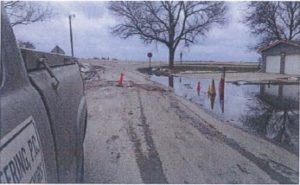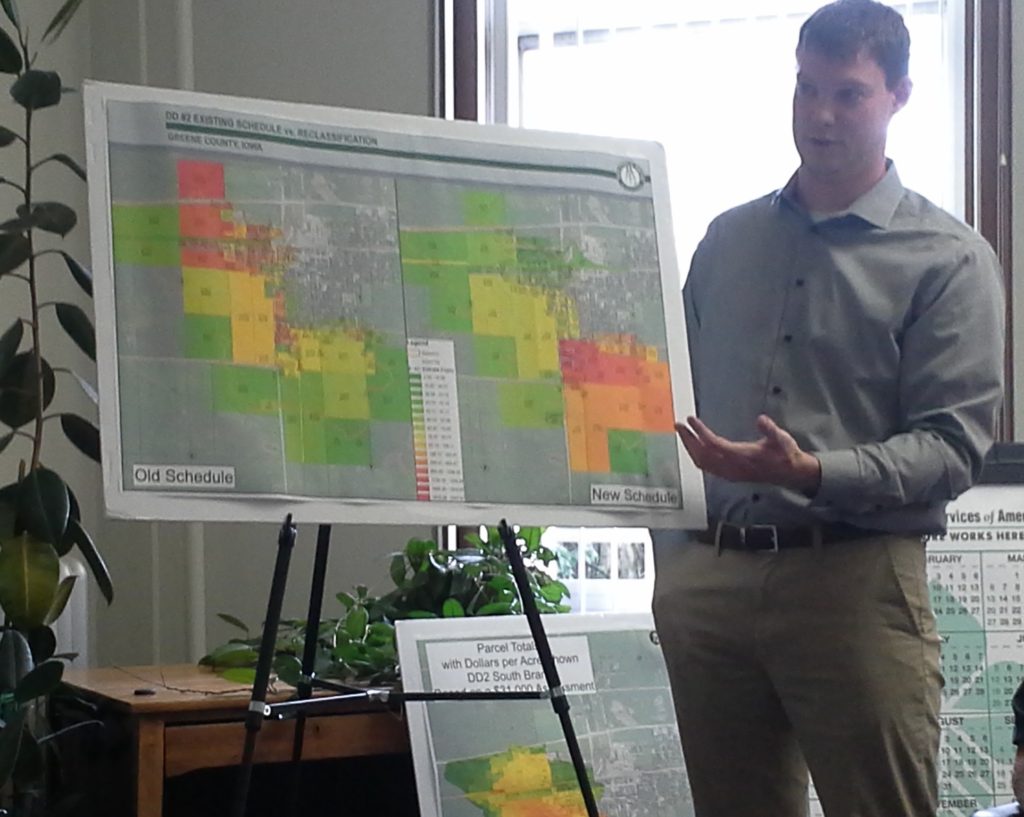The Greene County supervisors, as trustees of Drainage District 2, spent close to two hours Monday listening to public comments and discussing drainage issues in Grand Junction and the area to the northeast. In the end, they made the decisions that were rather obvious and postponed a decision on a more difficult question.

DD 2 was established in 1902 and tiles were placed in 1906. The district covers 2,106 acres and is considered in three branches – north, east, and south. As Grand Junction grew, the balance of agricultural land and residential land changed. Improvements were done in 1956 to the entire district except the southeast 1,500 feet of the south district, which includes the neighborhood near the school football field and Sunset Drive.
Landowners in drainage districts pay for all repairs and improvements according to a rather complicated formula based on the benefit each parcel receives from the work. When the benefit schedule for DD2 was revised in 1956, the entire district was put on one schedule. “That means that even though there are three branches… if you live in the south branch, when work is done in the east branch, you’re still going to pay for that east branch repair, and vice versa,” explained Bolton and Menk engineer Jacob Hagen at the meeting Monday.
Drainage problems became significant last fall and continued in the south branch as residents in the Sunset Drive neighborhood had flooded yards and wet basements. Bolton & Menk had the tiles “televised” and determined that tree roots growing into the tiles and trees over the tiles were creating problems. Tree roots were cleaned out at a cost of $70,000. Bolton & Menk was hired to investigate future repairs and improvements.
The report suggested a three-part project: clean out tree roots south of the railroad tracks, cost $7,000; repairing existing tile in the Sunset Drive neighborhood by installing cured in place pipe (rather like a stint in an artery) so that tree roots can’t grow into the tile, cost $70,000; and cleaning out the open ditch, cost $23,000.
Supervisor John Muir explained the history of the project. “We thought it would be an easy repair. Through the winter, seeing there were big issues, and questioning if the entire district should be responsible, we began to question if the district should be reclassified,” supervisor John Muir said. When the project was started in the fall, there had been no discussion of reclassification. “In my mind, that project of cleaning out the roots and getting it to work, because at that point it was an entire district, I see those costs as spread throughout the entire district,” he said.
“Moving forward, and this includes whether to replace the tile on Sunset or what to do, I see that as a cost that should go to that subdivision alone. They should be involved in the decision of what to do, but it’s going to primarily be their cost,” he said.
The public hearing had three stated purposes: accepting the engineer’s report, annexing parcels into the district, and reclassification of the district.
Discussion about accepting the report centered on a statement in the report about the assessment schedule. The report recommends reclassifying the south branch into two schedules, one for the lands east of Highway 144 and one including all of the south branch, “as it is unfair to expect the agricultural lands to pay for the tree root issues in town.”
After much discussion, the report was accepted as it lists recommendations and will be valid for 10 years.
The question of annexation received only brief discussion. There were random residential lots, most of them less than an acre but totaling 41 acres, there were not part of DD2 and will pay no cost of repair. They were annexed into DD2 and will pay a share of projects going forward.
Reclassification was the difficult issue. Under the current classification, property owners of the ag land in the northeast portion pay the vast majority of all costs because the benefit schedule is a per acre cost. The owner of 120 acres of ag land pays much more than the owner of a city lot, although they get little benefit from a project dealing with residential tree roots.
Bolton & Menk’s Hagen showed maps comparing the cost to various parcels in the current classification, and the cost if the district were reclassified with a revised benefit schedule. A revised benefit schedule would put the cost of future work in the Sunset Drive area (the proposed cured in place pipe at $70,000) on property owners there.

The supervisors/trustees did not make that decision at Monday’s meeting. They instead continued the public hearing on reclassification to Dec. 5. The $70,000 cost of the work already done in the Sunset Drive area will be assessed to the entire district according to the current benefit schedule. Bids will be requested for the open ditch clean-out for spring completion. That cost will also be assessed to the entire district as all parcels will receive benefit.
The recommended additional $70,000 project for Sunset Drive will not be acted upon until reclassification is determined.
The engineer’s report, with several photos, is posted on the Greene County website.
For the story of the history of drainage districts in Greene County, visit the Greene County Historical Society’s website for a recently posted “History Whisperer” column by Historical Society director Roger Aegerter.
